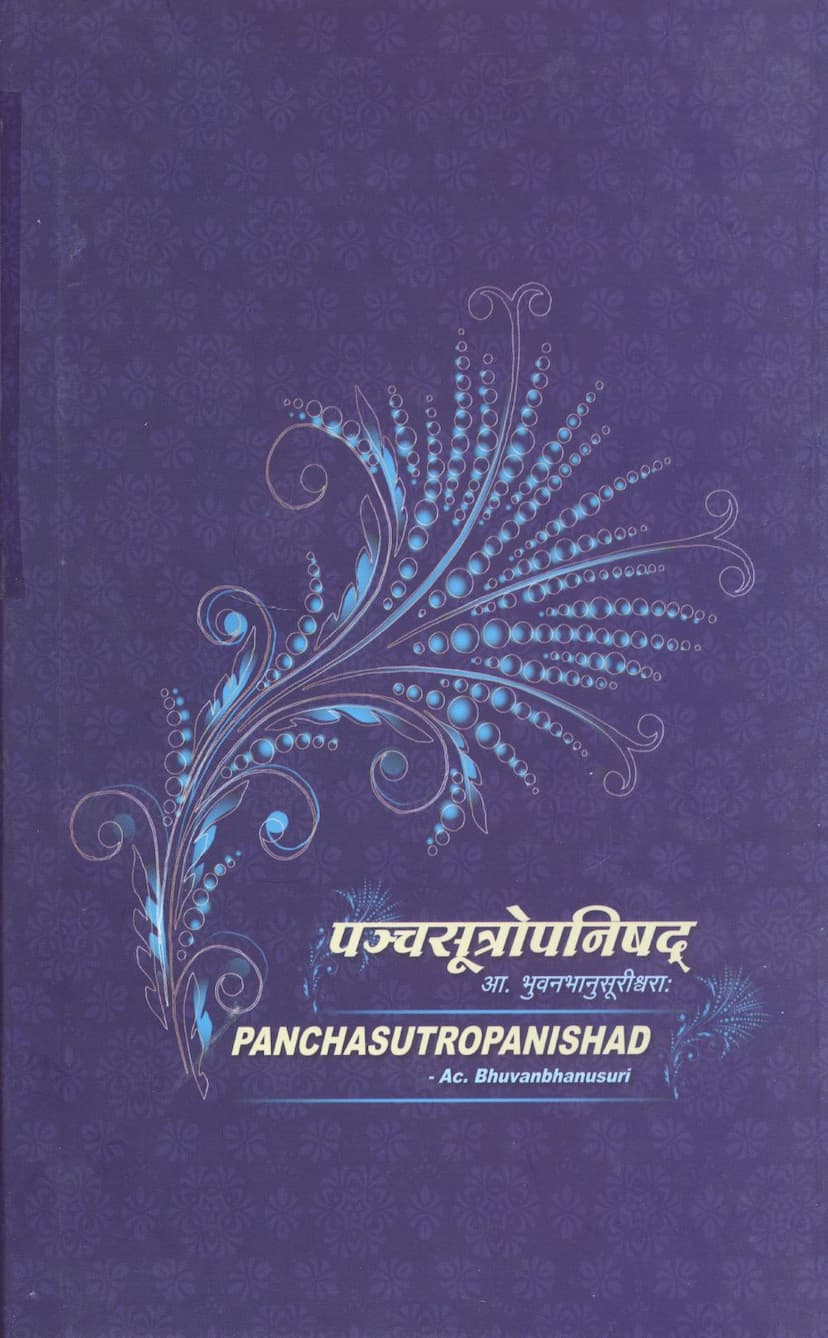Panchsutrop Nishad
Added to library: September 2, 2025

Summary
Here's a comprehensive summary of the Jain text "Panchesutrop Nishad" (पञ्चसूत्रोपनिषद्) based on the provided pages:
Book Title: Panchesutrop Nishad (पञ्चसूत्रोपनिषद्) Author(s): Acarya Bhuvanbhanusuri (with commentary by Acarya Kalyanbodhisuri) Publisher: Shree Jinshasan Aradhana Trust Catalog Link: https://jainqq.org/explore/022074/1
Core Concept:
The "Panchesutrop Nishad" is a profound Jain text that presents a concise yet comprehensive guide to the path of liberation (Moksha). It is structured around five fundamental sutras, each delving into a crucial aspect of spiritual progress, from the initial steps of purification to the ultimate attainment of liberation. The text emphasizes a systematic approach to spiritual development, guiding the aspirant through various stages of practice and understanding.
Key Themes and Structure:
The text is presented as a detailed commentary on the original "Panch Sutra" (पञ्चसूत्र) authored by an ancient Jain scholar (identified as possibly "Ajna Purvak Acharya" and later attributed to Chirantnacharya). The commentary is a Sanskrit translation and elaboration of the Gujarati commentary "Uchch Prakash Na Panthē" (ઉચ્ચ પ્રકાશના પંથે) by Acarya Bhuvanbhanusuri, with further editing and compilation by Acarya Kalyanbodhisuri.
The central theme revolves around the path to Moksha, addressing the cessation of suffering and the attainment of eternal bliss. The five sutras, and consequently the core topics covered, are:
-
Papapratighat Gunbijadhan (पापप्रतिघातगुणबीजाधान): This initial sutra focuses on prevention of sin and sowing the seeds of virtues. It highlights the importance of purifying the soul by abandoning sinful actions and cultivating virtuous qualities. This includes essential practices like taking refuge in the Arhats, Siddhas, Sadhus, and Dharma (the Four Sharanas), confessing one's wrongdoings (Dushkrit Garha), and appreciating good deeds (Sukrut Anumodana). These practices are presented as foundational for purifying the soul and developing the potential for spiritual growth. The text explains that this purification is achieved by destroying negative karmas and laying the groundwork for positive karmic influx.
-
Sadhu Dharma Paribhavana (साधुधर्मपरिभावना): This sutra delves into the cultivation and practice of monastic vows and conduct. After purifying the soul, the aspirant progresses towards understanding and embodying the principles of monastic life. This involves the acceptance and adherence to the twelve vows (Vratas), the development of spiritual qualities, and the understanding of virtuous conduct. It emphasizes the importance of avoiding negative influences (Kalyana Mitra Tyaga) and seeking the company of virtuous individuals (Kalyana Mitra Sampark). The text elaborates on the significance of right conduct, ethical behavior, and the renunciation of worldly attachments.
-
Pravrajya Grahan Vidhi (प्रव्रज्याग्रहणविधि): This sutra outlines the rituals and procedures for accepting monastic ordination (Pravrajya). It details the process of renouncing worldly life and embracing the path of a mendicant. This includes seeking permission from parents and elders, understanding the significance of the vows, and undergoing the necessary ceremonies. The text touches upon the dedication required for this transition and the profound commitment involved.
-
Pravrajya Paripalana Vidhi (प्रव्रज्यापरिपालनविधि): This sutra focuses on the sustenance and diligent practice of monastic vows after ordination. It emphasizes the importance of maintaining purity of mind, speech, and body, adhering to the discipline, and continuously striving for spiritual progress. This section likely discusses the practical aspects of monastic life, including meditation, scripture study, ethical conduct, and the management of desires and attachments. It highlights the need for continuous effort and vigilance in upholding the vows.
-
Pravrajya Phal Moksha (प्रव्रज्याफलमोक्ष): The final sutra elucidates the ultimate fruits of monastic practice, which is Moksha (liberation). It describes the state of liberation, characterized by the cessation of all suffering, the attainment of infinite knowledge, perception, bliss, and the eternal dwelling of the liberated soul in its pure, untainted form. The text likely elaborates on the nature of this supreme happiness and the means to achieve it.
Commentary and Significance:
- Acarya Bhuvanbhanusuri's Commentary: The current work is a Sanskrit translation and reinterpretation of Acarya Bhuvanbhanusuri's extensive Gujarati commentary, "Uchch Prakash Na Panthē" (ઉચ્ચ પ્રકાશના પંથે - "On the Path of High Light"). This commentary is highly regarded for its insightful explanations and its ability to reveal the profound secrets of the original verses.
- Acarya Kalyanbodhisuri's Role: Acarya Kalyanbodhisuri is credited with the Sanskrit translation, editing, and compilation of this work, making it accessible to a wider audience familiar with Sanskrit.
- Haribhadra Suri's Influence: The original "Panch Sutra" itself is considered a highly valuable text, embellished with a commentary by the great scholar Acarya Haribhadra Suri, a disciple of Yakini Mahattara. This lineage underscores the authenticity and depth of the teachings.
- Guidance for Sadhaks: The book is presented as an invaluable guide for spiritual seekers of all levels, offering precise guidance for achieving happiness in both this life and the hereafter, and providing a stepping stone towards achieving Moksha according to the tradition.
- Purpose of Publication: The translation into Sanskrit is intended to disseminate the wisdom of this profound commentary for thousands of years, illuminating the paths of many who are in darkness.
Target Audience:
The text is considered suitable for individuals seeking to cultivate purity of the soul, understand and practice monastic virtues, and ultimately achieve liberation. It is particularly recommended for those who are sincere in their spiritual pursuits and are willing to engage in deep study and contemplation of its teachings. The intended readers are those who are "Geetarth Guru Anugnyat Atma" (गीतार्थगुरुअनुज्ञातआत्मा), implying those who have received proper guidance from learned gurus.
Overall Message:
The "Panchesutrop Nishad" offers a structured, step-by-step approach to spiritual liberation. It emphasizes the eradication of sins, cultivation of virtues, proper conduct, rigorous practice, and the ultimate goal of Moksha. The text serves as a guide for individuals to achieve profound happiness and spiritual enlightenment, guiding them from the foundational principles to the highest realization of the soul.